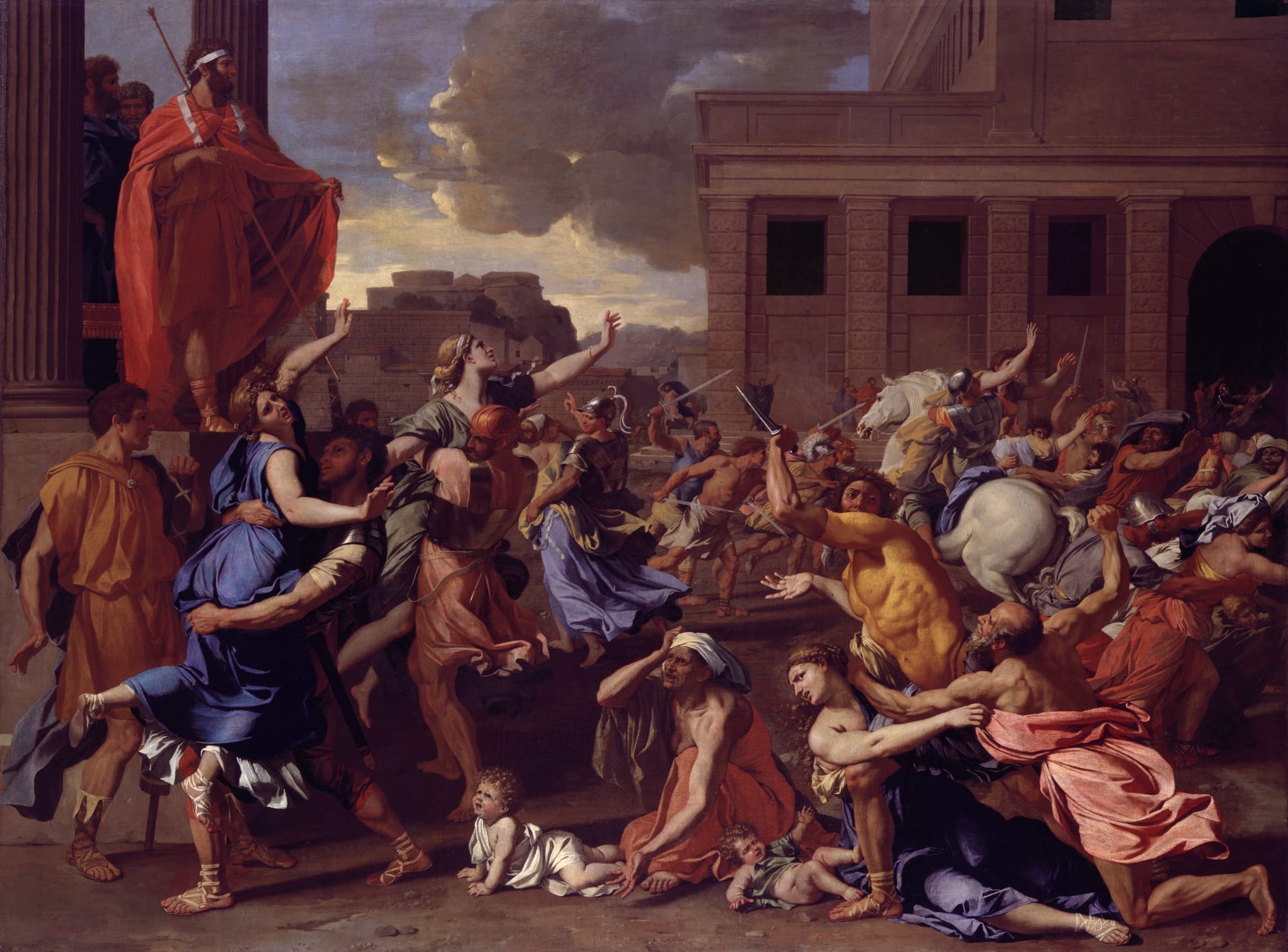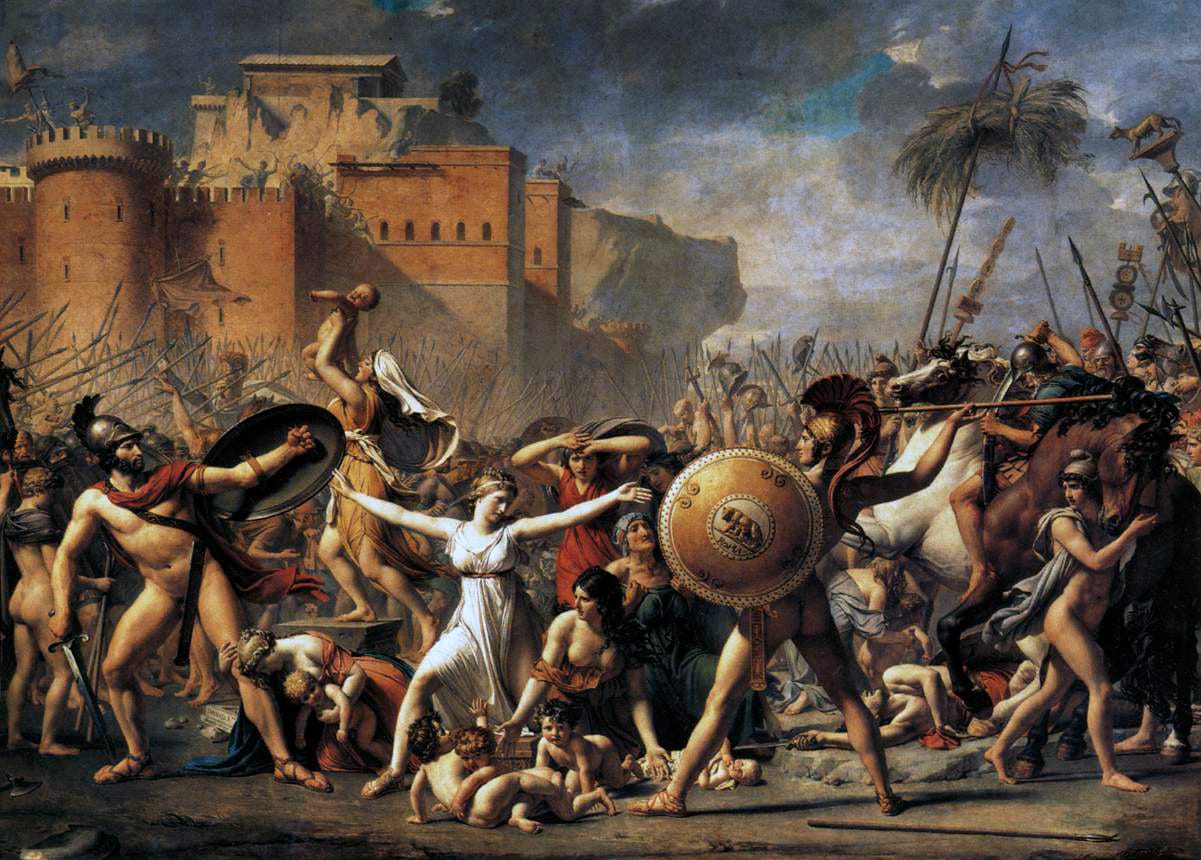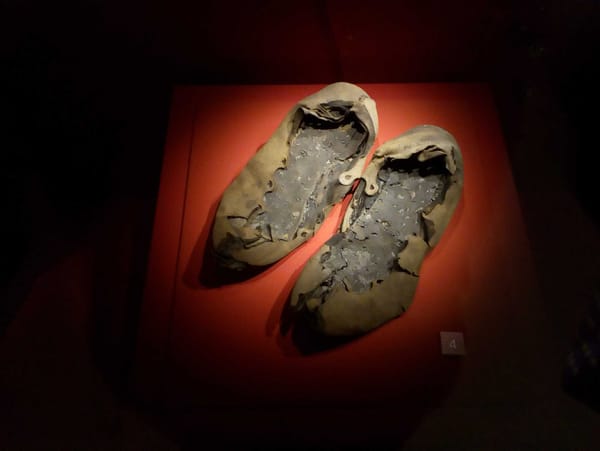What truly happened with the Sabine Women?
The story of the abduction of the Sabine women is part of the Roman Mythology, which especially during the Renaissance was a loved topic of expression.

The tale of the abduction of the Sabine Women is one of the darkest of Roman history. But is it true, or a myth? And if it is true, what has really happened? While it is evident that the story forms a part of Rome's founding mythology, its historical accuracy is disputed. Many historians consider it unlikely to have occurred as described, if at all.
Who were the Sabines?
During the Iron Age, the inhabitants of Central Italy transitioned from living in isolated hilltop settlements to forming larger communities. This shift often involved merging several older settlements into one larger group. In coastal areas with easy access to the sea and plains, this process led to the development of true cities, such as Antium, Satricum, archaic Rome, Praeneste, Veii, and Caere.
In the more rugged interior regions, this consolidation into larger political units, often termed "tribal" due to a lack of a better term, occurred at a slower pace. From north to south, four distinct groups emerged: the Sabines in the Tiber River valley, the Aequi, the Hernici in the Tolerus (modern Sacco) River valley, and the Volsci.
The Sabines, who likely spoke an Osco-Umbrian language, are frequently mentioned in early Roman history, notably in the legend of the Rape of the Sabine Women. Various conflicts between the Romans and Sabines are recorded, including the rule of two Sabine kings in Rome: Romulus' co-ruler Titus Tatius and his successor, the wise Numa Pompilius. Additionally, King Ancus Marcius had Sabine ancestry.
While powerful Roman kings like Tarquin the Proud managed to keep neighbouring tribes at bay, the collapse of the Roman monarchy in the late sixth century BCE led to the Aequi and Volsci migrating to the plains. The Sabines largely did not participate in this migration, with the exception of the Claudii family, who settled in Rome and became one of the key patrician families in the history of the Roman Republic.
Was it an abduction, or rape?
The Rape of the Sabine Women (Sabinae raptae in Latin) literally means 'the kidnapped Sabine women’ and it is also referred to as the Abduction of the Sabine Women or the Kidnapping of the Sabine Women and it is a significant event in the legendary history of Rome.
This incident involved the mass abduction of young women from the neighbouring cities by Roman men. It has been a popular theme for painters and sculptors, especially since the Renaissance.
It has to be underlined that the term "rape" (which is related to rapto in Portuguese and other Romance languages, meaning "kidnap") is the standard translation of the Latin word "raptio" used in ancient accounts of the event. The Latin term means "abduction" or "kidnapping", but when referring to women, it typically implies sexual assault.

It is not therefore determined whether the event was indeed an abduction, or worse
Closeup photo of a Sabine woman being violently abducted, during the event. Illustration: Midjourney
What is the story behind the abduction?
In the early days of Romulus' rule, military victories came swiftly for the nascent city of Rome. However, the city's long-term prospects hinged on increasing its population, which at the time consisted almost entirely of men.
Romulus sought assistance from neighbouring tribes, requesting that they send their women to live with the Roman men. As expected, the tribes refused. Romulus then adopted a different strategy. He organized festival games in honor of Neptune and extended invitations to all nearby tribes, including the Sabines.
While everyone was engrossed in the festivities, the Roman men launched a surprise attack on the Sabine women. According to Livy, they were "carried off". He notes that the Sabine women were exceptionally beautiful, implying this might explain their particular misfortune.
Livy attempts to soften the incident by mentioning that the Roman men claimed their actions were driven by love and passion. Later, the Sabine women intervened to prevent further bloodshed between their vengeful fathers and the Roman men, leading to a reluctant truce.
“Many people came, some simply out of curiosity to see the new city, and especially the nearest neighbours, from Caenina, Crustuminum and Antemnae; the entire Sabine population came, wives and children included. Received with hospitality in the houses, after having seen the position of the city, its walls, and the large number of buildings, they marvelled that Rome had grown so fast.
When it was time for the show, and everybody was concentrating on this, a prearranged signal was given and all the Roman youths began to grab the women. Many just snatched the nearest woman to hand, but the most beautiful had already been reserved for the senators and these were escorted to the senators’ houses by plebeians who had been given this assignment.
The story goes that one woman, far and away the most beautiful, was carried off by the gang of a certain Thalassius, and because many wanted to know where they were taking her, they repeatedly shouted that they were taking her to Thalassius, and that it how the nuptial cry came to be.
The party was over, and the grieving parents of the girls ran away, accusing the Romans of having violated the laws of hospitality and invoking the god who was supposed to have been honoured at that day’s festival. Nor did the girls themselves hold much hope.
But Romulus went among them in person to assure them that none of this would have happened if their fathers hadn’t been so inflexible in not letting them marry their neighbours. But now they would have the status of wives with all the material rewards and civil rights of citizenship and they would have children, than which nothing is dearer.
They should cool their anger and give their hearts to the men who had already taken their bodies. A good relationship often begins with an offence, he said. And their husbands would treat them with extra kindness in hope of making up for the parents and country they so missed. The men added their blandishments, saying that they’d been motivated by love and passion, entreaties which are very effective with women.”
Livy, Ab Urbe Condita
Livy portrays this episode not as a moral lesson about sexual violence, but as a crucial event that solidified Romulus' authority. He argues that the abduction of the Sabine women was instrumental in the rise of Rome as a powerful city. Consequently, Romulus was able to establish himself as the first king of Rome, ensuring the city's continued prosperity.
Ovid, in his Ars Amatoria, (The Art of Love), presents a completely different perspective on the abduction of the Sabine women. He does not present it as something that had to happen in order for the Roman Empire to be built. He presents it as it is: an abduction.
"The monarch gave the signal from his throne,
And rising, bade his merry men fall on.
The martial crew, like soldiers, ready press'd,
Just at the word (the word too was the best),
With joyful cries each other animate;
Some choose, and some at hazard seize their mate.
As doves from eagles, or from wolves the lambs,
So from their lawless lovers fly the dames.
Their fear was one, but not one face of fear:
Some rend the lovely tresses of the hair:
Some shriek, and some are struck with dumb despair.
Her absent mother one invokes in vain;
One stands amaz'd, not daring to complain;
The nimbler trust their feet, the slow remain.
But nought availing, all are captives led,
Trembling and blushing, to the genial bed.
She who too long resisted or denied,
The lusty lover made by force a bride,
And with superior strength compell'd her to his side. Then sooth'd her thus! "My soul's far better part,
Cease weeping, nor afflict thy tender heart;
For what thy father to thy mother was,
That faith to thee, that solemn vow I pass!"
He does not show the same respect and admiration to Romulus as Livy did:
"Thus Romulus became so popular;
This was the way to thrive in peace and war;
To pay his army, and fresh whores to bring:
Who wouldn't fight for such a gracious king!
Thus love in theatres did first improve,
And theatres are still the scene of love.
Nor shun the chariots and the courser's race;
The circus is no inconvenient place."
Ovid. Ars Amatoria

The aftermath of the abduction
In Roman mythology, the Battle of the Lacus Curtius was the decisive confrontation in the war between the Roman Kingdom and the Sabines. This conflict followed Rome's mass abduction of Sabine women to take as brides. The battle occurred during the reign of Romulus, near the Lacus Curtius, which would later become the site of the Roman Forum.
According to Livy, suddenly, the abducted Sabine daughters rushed onto the battlefield, placing themselves between the two armies. They pleaded with both sides to cease the bloodshed and recognize each other as family, given their new kinship ties. Ashamed, the leaders of both peoples ended the fighting.
In his account of the Battle of the Lacus Curtius, Plutarch adds more details, though the core narrative aligns with that of Livy. He notes that when the women intervened, they not only halted the battle but also brought food, water, and care for the injured. They took the opportunity to introduce their husbands to their fathers. From then on, Sabine women had no other duty but to spin wool for their husbands.
After that, a treaty was signed and peace came.
Livy Vs Ovid in the Sabine War
Two authors, writing at opposite ends of the Augustan Age, explore the story of the Sabine women with distinct objectives.
Livy, writing in the mid-twenties, uses the tale to reinforce Roman national character. By contrasting the Sabine women with Tarpeia, (In Roman legend, Tarpeia (mid-8th century BCE) was the daughter of the Roman commander Spurius Tarpeius. She served as a Vestal Virgin and betrayed Rome to the Sabines during the time of the women's abduction, believing she would be rewarded with jewelry.
However, instead of receiving a reward, she was crushed to death by Sabine shields, and her body was thrown from the southern cliff of Rome's Capitoline Hill, which was subsequently named Tarpeian Rock (Rupes Tarpeia) in her memory), he illustrates what it means to be a “good” versus “bad” Roman woman, offering examples for Romans to emulate.

Livy's narrative implies a strict gender hierarchy foundational to the Roman state. He elevates Romulus and the Roman men as leaders and warriors, while praising the Sabine women for their submission, loyalty, and self-sacrifice.
In contrast, in "Fasti" Book 3, written at the end of Augustus’ reign, Ovid challenges Livy’s male-centric account. Ovid’s portrayal of the Sabine war emphasizes the women’s agency and their crucial role in establishing state stability. He also highlights the aggressive attempts of men to assert control over these women. Analyzing the women’s speeches in each account reveals the authors' differing perspectives on gender and power in Rome.





About the Roman Empire Times
See all the latest news for the Roman Empire, ancient Roman historical facts, anecdotes from Roman Times and stories from the Empire at romanempiretimes.com. Contact our newsroom to report an update or send your story, photos and videos. Follow RET on Google News, Flipboard and subscribe here to our daily email.
Follow the Roman Empire Times on social media: